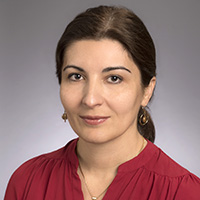As the only National Cancer Institute-Designated Comprehensive Cancer Center in Georgia, Winship is a leader in the treatments for sarcoma, conducting innovative research and clinical trials that are transforming how these cancers are identified, treated, and survived.
The radiation oncologists at Emory Proton Therapy Center work with the multidisciplinary Sarcoma cancer team at Winship, which includes experts in sarcoma surgical oncology, orthopedicopaedic oncology, thoracic surgery, sarcoma medical oncology, radiology, sarcoma pathology, supportive oncology, dieticians, social workers, physical therapy, and cancer rehabilitation. Your radiation oncologist will work closely with these other specialists to customize your sarcoma treatment plan and coordinate your care. We can also partner and coordinate with a patient’s existing care team, whether they are across town or around the world.
Proton Therapy for Sarcoma
A sarcoma diagnosis can be one of the biggest challenges you and your family will ever face. Our team is dedicated to helping you meet that challenge through compassionate care using the most advanced treatments for sarcoma available. Proton therapy may be a more precise radiation option for treatment of your sarcoma to help protect the function of important nearby organs, as well as reducing the risk of developing a future cancer. Our cancer specialists will work with you to develop a personalized treatment plan which aims for fewer side effects and improved quality of life.
What We Treat
- Retroperitoneal sarcomas
- Abdominal sarcomas
- Pelvic sarcomas
- Bone sarcomas
- Chordomas
- Chondrosarcoma
- Ewing’s sarcoma
- Rhabdomyosarcoma
- Liposarcoma
- Leiomyosarcoma
- Osteosarcoma
- Desmoid tumors
- Sarcoma metastases (lymph nodes, lung, liver, or adrenal)
- Re-irradiation
Benefits of Proton Therapy
Sarcomas may occur anywhere in the body. Potential benefits of proton therapy depend on the type of sarcoma and location in the body. Click below to see the benefits for proton therapy for each body site.
Benefits for Head & Neck Sarcomas
- Reduced risk of painful sores in the mouth (mucositis) during treatment.
- Reduced risk of dental decay after radiation.
- Reduced risk of problems swallowing (dysphagia or aspiration) during or after therapy.
- Reduced risk of hoarseness during treatment.
- Reduced risk of dry mouth (xerostomia) after radiation.
- Reduced risk of hearing loss after radiation. This is relevant for tumors near the cochlea, such as those in the nasopharynx, paranasal sinuses, or skull base.
- Reduced risk of hormone imbalances (endocrine dysfunction) which can particularly affect growth and development in children and young adults. This is relevant for tumors near the pituitary and hypothalamus, such as those in the nasopharynx, paranasal sinuses, or skull base.
- Reduced radiation to the bone marrow and circulating lymphocytes, which may help support the function of the immune system in taking on cancer.
- Reduced risk of developing a future second tumor or cancer, which is most relevant in younger patients, those with a good prognosis and a long life expectancy, and those patients who may have genetic conditions putting them at higher risk for developing other cancers.
Benefits for Chest Sarcomas
- Reduced risk of inflammation of the heart (pericarditis) and future heart problems like hardening of the arteries (atherosclerosis), stiffening of the heart muscle (fibrosis, cardiomyopathy), and heart attacks.
- Reduced risk of inflammation of the lungs (radiation pneumonitis) and problems with lung function (lung fibrosis).
- Reduced risk of difficulty or pain with swallowing (dysphagia or odynophagia) or chronic narrowing of the esophagus (stricture).
- Reduced radiation to the bone marrow and circulating lymphocytes, which may help support the function of the immune system in taking on fighting cancer.
- Reduced risk of low blood counts (anemia, neutropenia) which may support the body’s tolerance of chemotherapy.
- Reduced risk of developing a future second tumor or cancer, which is most relevant in younger patients, those with a good prognosis and a long life expectancy, and those patients who may have genetic conditions putting them at higher risk for developing other cancers.
Benefits for Retroperitoneal, Abdominal or Pelvic Sarcomas
- Reduced risk of inflammation of the heart (pericarditis) and future heart problems like hardening of the arteries (atherosclerosis), stiffening of the heart muscle (fibrosis, cardiomyopathy), and heart attacks.
- Reduced risk of new or worsening problems with liver function (radiation induced liver dysfunction). This is relevant for patients with large liver tumors and/or small remaining size of normal liver, for those with poor liver function (liver cirrhosis), or those who have had prior radiation treatments including prior liver radioembolization.
- Reduced risk of nausea and diarrhea.
- Reduced risk of new or worsening kidney function.
- Reduced risk of frequent urination or stinging or burning with urination during treatment, or of chronic urinary problems after treatment.
- Reduced risk of diarrhea and rectal soreness (proctitis) during treatment and of chronic rectal problems after treatments such as rectal bleeding or ulceration.
- Reduced radiation to the bone marrow, spleen, and circulating lymphocytes, which may help support the function of the immune system in fighting cancer.
- Reduced risk of low blood counts (anemia, neutropenia) which may support the body’s tolerance of chemotherapy.
- Reduced risk of developing a future second tumor or cancer, which is most relevant in younger patients, those with a good prognosis and a long life expectancy, and those patients who may have genetic conditions putting them at higher risk for developing other cancers.
Benefits for Skull Base or Spine Sarcomas
- Improved ability to treat radiation- resistant sarcomas near the brainstem or spinal cord with a high dose of radiation necessary for these tumors.
- Reduced risk of inflammation of the heart (pericarditis) and future heart problems like hardening of the arteries (atherosclerosis), stiffening of the heart muscle (fibrosis, cardiomyopathy), and heart attacks. This is relevant for tumors near the heart, for example in the thoracic spine.
- Reduced risk of inflammation of the lungs (radiation pneumonitis) and lung function (lung fibrosis). This is relevant for tumors near the lungs, for example in the thoracic spine.
- Reduced risk of nausea and diarrhea. This is relevant for tumors near the bowels, for example in the lumbar or sacral spine.
- Reduced radiation to the bone marrow and circulating lymphocytes, which may help support the function of the immune system in taking on fighting cancer.
- Reduced risk of low blood counts (anemia, neutropenia) which may support the body’s tolerance of chemotherapy.
- Reduced risk of developing a future second tumor or cancer, which is most relevant in younger patients, those with a good prognosis and a long life expectancy, and those patients who may have genetic conditions putting them at higher risk for developing other cancers.
Schedule a Consultation
What To Expect From Proton Therapy
The first step in your care is a consultation. During consultation, we review your medical history, perform a physical exam, decide if any additional tests are needed, discuss all radiation options that may be appropriate for your treatment plancare, make recommendations, and answer questions.
To plan your treatment, you will undergo a “simulation” or planning session. During this visit our radiation therapists will help position you the way you will be treated each day. A CT scan will be done to create a picture of you in the treatment position to design your radiation plan. Some patients also undergo an MRI during this visit to help identify the target for treatment. It normally takes 10 days for the team to design the proton treatment plan and perform the quality assurance checks before treatment begins.
Depending on the type of tumor and stage, proton therapy may be delivered over one to three weeks, six weeks, or eight weeks of therapy. Typically, radiation is given once daily during the weekdays, Monday through Friday. For those receiving five treatments or fewer, proton therapy may be delivered every other day. While some situations are treated with radiation alone, proton therapy is often integrated with surgery, chemotherapy, immunotherapy, or other cancer treatments as part of a comprehensive plan of care.
Like other types of radiation, proton therapy treatments are invisible and painless. Most sarcoma tumor treatments average 30 minutes each day in the treatment room. If your tumor is located in the abdomen, it may move significantly while breathing. During your radiation planning process, your team will identify the most appropriate methods to manage tumor motion, if necessary.
Patients are seen by the radiation oncology physician team weekly during treatment to monitor progress, answer questions, address concerns, and manage any side effects from treatment. Your radiation oncologist will discuss a plan to assess response to treatment and for long-term follow-up after therapy.
Studies on Proton Therapy in Sarcoma
Our team has identified these studies as examples of the clinical benefits of proton therapy in sarcoma.
Spot scanning proton therapy in the curative treatment of adult patients with sarcoma: the Paul Scherrer institute experience
This retrospective report examined the outcomes of 13 patients treated with sarcoma of various types who either had a residual tumor that could not be removed by surgery or recurrent sarcoma after prior surgery. These sarcomas were located close to an important normal organ such as the bowel, spinal cord, or vision centers. Proton therapy was able to deliver a higher dose of radiation, 70 Gy, than is typically possible for tumors next to critical structures. At 4-years after treatment, the likelihood of treated tumor control was 74% and serious toxicity was observed in only 1 patient. This compares very favorably to other options for patients with unresectable sarcomas.
Long term outcome of skull-base chondrosarcoma patients treated with high-dose proton therapy with or without conventional radiation therapy
This retrospective study from two proton centers reported on outcomes of 251 patients treated with proton therapy (with or without a component of photon therapy) for skull base chondrosarcomas. Proton therapy was used to more safely deliver the higher dose of radiation needed to treat chondrosarcomas (the average dose was 70 Gy). At 7 years following treatment, the likelihood of tumor control was 93%. This is one of the largest series of skull base chondrosarcomas with long follow-up and the outcomes are among the best in the literature for radiation outcomes in this disease. Fifteen percent of patients developed a late toxicity, which were more common in patients with a larger volume of residual disease at the time of radiation. A multi-disciplinary approach for skull base tumors to ensure optimal surgery prior to radiation is important for the best outcomes and lowest toxicities.
Proton-based radiotherapy for unresectable or incompletely resected osteosarcoma
This retrospective study reported on 55 patients who were treated with proton therapy (with or without a component of photon therapy) for osteosarcoma. These were patients with tumors which could not be reasonably removed by surgery, or who had residual tumors after surgery. Proton therapy was used to more safely deliver the higher dose of radiation needed to treat osteosarcomas (the average dose was nearly 70 Gy). At 5 years following treatment, the likelihood of tumor control was 72%, which appears superior to the best results which have been published using x-ray based treatment for this challenging disease.
Long term outcomes of patients with skull-base low-grade chondrosarcoma and chordoma patients treated with pencil beam scanning proton therapy
This retrospective study included 151 patients with clival or skull base chordomas and 71 patients with skull base chondrosarcomas. Proton therapy was used to more safely deliver the higher dose of radiation needed to treat chordoma (74 Gy) and chondrosarcoma (70 Gy). At 7 years following treatment, the likelihood of tumor control was 71% for those with chordoma and 94% for chondrosarcoma. This is one of the largest series of skull base chordomas with long follow-up and the outcomes are among the best in the literature at 7-years post-treatment for radiation outcomes in this disease. A larger volume of residual tumors as well as residual tumors next to the brainstem or vision centers was associated with a higher risk of tumor progression. A multi-disciplinary approach for skull base tumors to ensure optimal surgery prior to radiation is important for the greatest outcomes.
Patient Stories
“I’ve been through it, and I can’t say enough about the amazing care I received. The team who handled my treatments was absolutely wonderful, making a difficult time so much easier to navigate.”

My experience at Emory was incredible—it was as easy as drinking water! The therapy sessions only took about 5 to 10 minutes, and right after, I’d go for a 4-mile walk every single day. I had no side effects whatsoever—I can’t even tell that I had the treatment. Emory truly saved my life, and I couldn’t be more grateful.

Stephen, a 36-year old father from Columbus, Georgia, is one of the almost 2000 patients who have been treated at the Emory Proton Therapy Center since it opened in December 2018. He completed six weeks of proton therapy to treat a brain tumor.

“I went through 37 treatments for prostate cancer at the Emory Proton Center two years ago. The care I received from their team of professionals was amazing. I was willing to travel from South Carolina for treatment, and I’m so thankful I did. I started this fight in 2017 and today my PSA is still undetectable. Truly amazing folks.”

Proton therapy gave Zack his best shot at treating a spinal tumor that had come back. Zack was one of the first patients treated at the Emory Proton Therapy Center after it opened in 2018. The treatments, every weekday for six weeks, took less than one hour of his day and gave Zack the greatest odds of a long life with his wife and children.

Tony was diagnosed with prostate cancer in 2019 and sought care from experts at Emory Proton Therapy Center. He’s confident that the advanced radiation therapy gave him the best cancer treatment possible and says the comfort and care he got from Winship doctors and staff were unmatched. “There were many great solutions here in Atlanta, but the best to me was Emory Proton Therapy Center,” says Tony.




